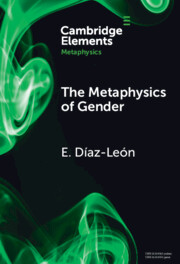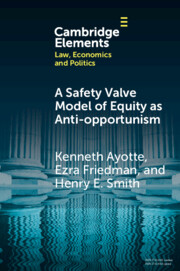Refine search
Actions for selected content:
43 results
The Stakes Effect: New Evidence from a Retraction-Based Experimental Design
-
- Journal:
- Episteme , First View
- Published online by Cambridge University Press:
- 13 August 2025, pp. 1-22
-
- Article
-
- You have access
- Open access
- HTML
- Export citation
Contextualism and the truth norm
-
- Journal:
- Episteme , First View
- Published online by Cambridge University Press:
- 05 March 2025, pp. 1-13
-
- Article
-
- You have access
- Open access
- HTML
- Export citation
Chapter 22 - Standing on the Shoulders of Giants while Frantically Learning to Swim
-
-
- Book:
- Pillars of Developmental Psychology
- Published online:
- 14 February 2025
- Print publication:
- 20 February 2025, pp 245-255
-
- Chapter
- Export citation

The Metaphysics of Gender
-
- Published online:
- 06 February 2025
- Print publication:
- 06 February 2025
-
- Element
- Export citation
Some Acts Really Harm: A Defense of the Standard Account versus Norcross's Contextualism
-
- Article
-
- You have access
- Open access
- HTML
- Export citation
From Contextualism to Contrastivism in Moral Theory
-
- Article
-
- You have access
- Open access
- HTML
- Export citation
Chapter 14 - The Losers’ Legacy
- from Epilogue
-
-
- Book:
- Writing Literary History in the Greek and Roman World
- Published online:
- 07 June 2024
- Print publication:
- 27 June 2024, pp 305-324
-
- Chapter
- Export citation
Fictional Creationism and Negative Existentials
-
- Journal:
- Canadian Journal of Philosophy / Volume 53 / Issue 3 / April 2023
- Published online by Cambridge University Press:
- 11 March 2024, pp. 193-208
-
- Article
-
- You have access
- Open access
- HTML
- Export citation
Chapter 8 - Ethics
-
- Book:
- Pragmatism and Methodology
- Published online:
- 04 January 2024
- Print publication:
- 25 January 2024, pp 161-182
-
- Chapter
-
- You have access
- Open access
- HTML
- Export citation

A Safety Valve Model of Equity as Anti-opportunism
-
- Published online:
- 14 August 2023
- Print publication:
- 07 September 2023
-
- Element
- Export citation
1 - Introduction: The Centrality of Regulation in Corporate Responsibility
-
-
- Book:
- Corporate Social Responsibility Across the Globe
- Published online:
- 15 June 2023
- Print publication:
- 01 June 2023, pp 1-8
-
- Chapter
- Export citation
7 - SMEs: An Untapped Platform for Sustainable CSR Penetration and Practice in Developing and Emerging Markets
- from Part II - Infusing Corporate Social Responsibility in Corporate Governance
-
-
- Book:
- Corporate Social Responsibility Across the Globe
- Published online:
- 15 June 2023
- Print publication:
- 01 June 2023, pp 155-174
-
- Chapter
- Export citation
3 - Incentives, Public Procurement and Market Mechanisms
- from Part I - Regulation Concepts, Paradigms and Approaches for Corporate Social Responsibility
-
-
- Book:
- Corporate Social Responsibility Across the Globe
- Published online:
- 15 June 2023
- Print publication:
- 01 June 2023, pp 39-64
-
- Chapter
- Export citation
2 - The Values System Paradigm As a Regulatory Alternative to Stakeholder Needs CSR
- from Part I - Regulation Concepts, Paradigms and Approaches for Corporate Social Responsibility
-
-
- Book:
- Corporate Social Responsibility Across the Globe
- Published online:
- 15 June 2023
- Print publication:
- 01 June 2023, pp 11-38
-
- Chapter
- Export citation
Stage 7 - Utterance Meaning, or What Lurks under the Surface
-
- Book:
- Semantics, Pragmatics, Philosophy
- Published online:
- 22 March 2023
- Print publication:
- 16 March 2023, pp 236-290
-
- Chapter
- Export citation
Computational rifts: Parsing the context of Early Modern Natural Philosophy
-
- Journal:
- Science in Context / Volume 36 / Issue 1 / March 2023
- Published online by Cambridge University Press:
- 27 June 2025, pp. 1-37
- Print publication:
- March 2023
-
- Article
-
- You have access
- Open access
- HTML
- Export citation
WOMAN: An Essentially Contested Concept
-
- Journal:
- Dialogue: Canadian Philosophical Review / Revue canadienne de philosophie / Volume 62 / Issue 2 / August 2023
- Published online by Cambridge University Press:
- 06 February 2023, pp. 357-374
-
- Article
-
- You have access
- Open access
- HTML
- Export citation
7 - Context
- from Part II - The framework of statutory interpretation
-
- Book:
- Modern Statutory Interpretation
- Published online:
- 05 January 2023
- Print publication:
- 10 January 2023, pp 83-97
-
- Chapter
- Export citation
Peace, war, law: teaching international law in contexts
-
- Journal:
- International Journal of Law in Context / Volume 18 / Issue 4 / December 2022
- Published online by Cambridge University Press:
- 22 November 2022, pp. 393-402
-
- Article
-
- You have access
- Open access
- HTML
- Export citation
Humanizing Science and Philosophy of Science: George Sarton, Contextualist Philosophies of Science, and the Indigenous/Science Project
-
- Journal:
- Canadian Journal of Philosophy / Volume 52 / Issue 3 / April 2022
- Published online by Cambridge University Press:
- 20 October 2022, pp. 256-278
-
- Article
-
- You have access
- Open access
- HTML
- Export citation
